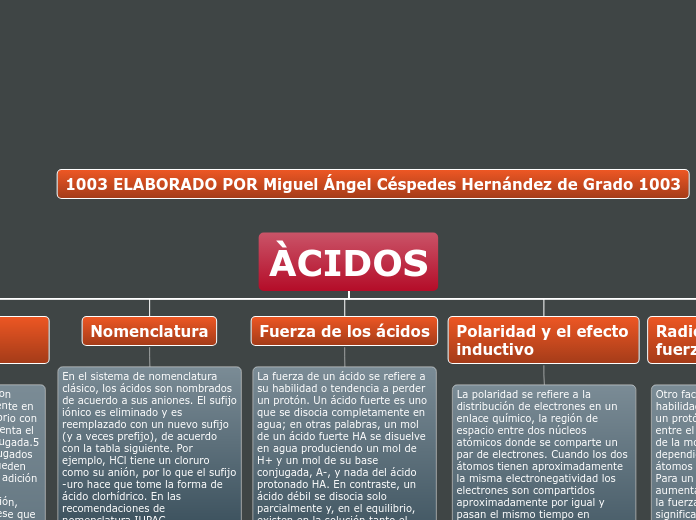COMPUESTOS INORGANICOS
Conflict is present everywhere in the world around us. We experience conflict on a daily basis, and it can be minor or major.
Conflict in a story is a struggle between opposing forces. Characters must act to confront those forces and there is where conflict is born. If there is nothing to overcome, there is no story. Conflict in a story creates and drives the plot forward.
6. OXIDOS
In this type of conflict, a character must take on society itself, and not a single person. The character stands at odds with societal norms and realizes the necessity to work against these norms. This is an external conflict.
FORMACIÓN
Se forma al juntar un elemento con el oxígeno y, al momento de formarse el oxigeno actúa con un numero de oxidación de -2, por el otro lado el elemento actúa con un numero positivo
Se forma al unir dos elementos, algún elemento más oxígeno
Es un compuesto inorgánico
DIVISION
Óxidos básicos
también
llamados óxidos metálicos, son combinaciones binarias del oxígeno con un metal.
5. HIDRÓXIDOS
This situation results from a protagonist working against what has been foretold for that person. While this conflict was more prevalent in stories where gods could control fate, such as in ancient Greek dramas, there are still examples of this type of conflict in more contemporary literature.
¿ Como se nombran?
Since in real life we can't say that such examples of man versus supernatural, there are some superstitions that can influence a person's life.
Give examples of these superstitions.
Se nombran con las palabras “hidróxido de” seguido del nombre del metal y entre paréntesis el número de oxidación, en números romanos, en el caso de que tenga más de uno.
Ejemplos
Hidróxido de bario, Ba(OH)2: Utilizado en la fabricación de cerámicas y distintos tipos de venenos.
DEFINICIÓN
Give examples of man versus fate conflict in a literary work.
Son un grupo de compuestos químicos que se forman al juntar hidrógeno, agua, por sustitución de uno de sus átomos de hidrógeno, más un metal.
4. PERÓXIDOS
A more contemporary type of conflict, this situation results from humans involved in a struggle with man-made machines. This is an external conflict.
FORMACIÓN:
As this conflict is more science fiction based, in real life we can't find such examples.
However, as technology became a big part of our lives there are some situations that man made machines affects our lives.
Find such examples.
Los elementos con números de oxidación 2serán 1:2
Los peróxidos tienen diferentes estructuras, los elementos con número de oxidación 1 serán 2:2.
Ca OH 2= Hidróxido de calcio / Cr OH 3=Hidróxido de cromo(III)
Give examples of man versus machine conflict in a literary work.
compuestos
3. HALOGENOS
This conflict develops from a protagonist’s inner struggles and may depend on a character trying to decide between good and evil or overcoming self-doubt. This conflict has both internal and external aspects, as obstacles outside the protagonist's force them to deal with inner issues.
PROPIEDADES FÍSICAS
Give examples of man versus self conflict in the real world.
Sólido.
Yodo y ástato.
Líquido.
Bromo.
Gaseoso.
Flúor y cloro.
Give examples of man versus self conflict in a literary work.
Presentan comportamientos químicos semejantes, como el hecho de formar sales de sodio (Na) muy parecidas.
Se llama halógenos a los seis elementos químicos que se encuentran en el grupo 17 (VIIa) de la tabla periódica.
USOS
Los compuestos con bromo (bromuros) se emplean como sedantes, como material para la industria fotográfica, y como antiséptico (en el caso del yodo).
Se utilizan en el tratamiento del agua potable y del agua de piscinas.
Intervienen en la fabricación de lámparas, blanqueadores y detergentes.
2. ÁCIDOS
In this type of conflict, a character is tormented by natural forces such as storms or animals. This is also an external conflict.
TIPOS
Give examples of man versus nature conflict in the real world.
Ácidos débiles
Son los compuestos químicos que no liberan iones de hidrógeno (H+) en gran cantidad.
Ácidos fuertes
Son aquellos compuestos capaces de liberar iones de hidrógeno (H+) con facilidad en una solución.
CARACTERÍSTICAS
Son solubles en agua
se disocian o se disuelven en agua con facilidad.
Su nivel de pH es inferior a 7.
el pH mide la concentración de iones (H+) en una solución.
Al reaccionar con metales generan hidrógeno (H) y sal.
Son conductores de energía eléctrica.
Este tipo de energía fluye con facilidad a través de sus iones.
QUÉ SON?
Give examples of man versus nature conflict in a literary work.
CONECTOR*
Todo compuesto químico que libera o cede iones de hidrógeno (H+) en solución acuosa.
1. SALES
A situation in which two characters have opposing desires or interests. The typical scenario is a conflict between the protagonist and antagonist. This is an external conflict.
CLASIFICACIÓN
Give examples of man versus man conflict in the real world.
ELEMENTOS
Sales cuaternarias.
Presentan cuatro elementos diferentes, entre metales y no metales.
NaHCO3
Sales ternarias.
Presentan tres elementos: un metal, un no metal y oxígeno.
PbSeO3
Sales binarias.
Presentan dos elementos: un metal y un no metal.
Ejemplo
NaCl
COMPOSICIÓN
Sales hidratadas.
Sales en cuya composición cristalina aparecen moléculas de agua.
Sales mixtas.
Compuestas por dos cationes o dos aniones distintos, que presentan iones diferentes a H+ y OH-.
Sales neutras.
Producto de la neutralización total de un ácido y una base, carecen de iones H+ y OH- debido a su carácter neutro.
Sales ácidas o sódicas.
Se componen de dos cationes y un anión.
Sales básicas o hidroxisales.
Compuestas por dos aniones y un catión.
QUÉ ES?
Give examples of man versus man conflict in a literary work.
SON
Compuestos químicos fruto de un enlace iónico entre partículas químicas con carga positiva (cationes) y otras con carga negativa (aniones).









